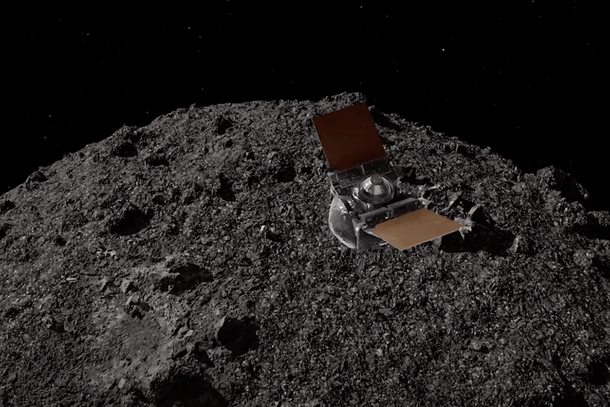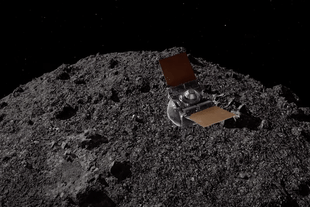Science
NASA Scientists Make 'Astonishing' Discovery About Asteroid Set To Make Close Approach With Earth In 2135
Swarajya Staff
Jul 08, 2022, 10:19 AM | Updated 05:53 PM IST
Save & read from anywhere!
Bookmark stories for easy access on any device or the Swarajya app.


After analysing data gathered when NASA’s OSIRIS-REx spacecraft collected a sample from asteroid Bennu, named after Egyptian mythological bird, in October 2020, scientists have learned something astonishing: The spacecraft would have sunk into Bennu had it not fired its thrusters to back away immediately after it grabbed dust and rock from the asteroid’s surface, a NASA release said on Thursday.
The NASA Origins, Spectral Interpretation, Resource Identification, Security-Regolith Explorer (OSIRIS-REx) spacecraft was launched aboard a United Launch Alliance Atlas V rocket in August 2016 to collect surface material from Bennu and return it to Earth for study.
After traveling through space for more than two years and over two billion kilometers, the spacecraft arrived at its destination, asteroid Bennu, on 3 December 2018.
On 20 October 2020, OSIRIS-REx collected sample from the asteroid during a “Touch-And-Go” (TAG) maneuver.
On 10 May 2021, the spacecraft embarked on its return voyage to Earth.
The scientists analysing the data from the spacecraft found that the particles making up Bennu’s exterior are so loosely packed and lightly bound to each other that if a person were to step onto Bennu they would feel very little resistance, as if stepping into a pit of plastic balls that are popular play areas for kids.
“If Bennu was completely packed, that would imply nearly solid rock, but we found a lot of void space in the surface,” said Kevin Walsh, a member of the OSIRIS-REx science team from Southwest Research Institute, which is based in San Antonio.
The latest findings about Bennu’s surface were published on 7 July in a pair of papers in the journals Science and Science Advances, led respectively by Dante Lauretta, principal investigator of OSIRIS-REx, based at University of Arizona, Tucson, and Walsh. These results add to the intrigue that has kept scientists on the edge of their seats throughout the OSIRIS-REx mission, as Bennu has proved consistently unpredictable, NASA said in a release.
The asteroid presented its first surprise in December 2018 when NASA’s spacecraft arrived at Bennu. The OSIRIS-REx team found a surface littered with boulders instead of the smooth, sandy beach they had expected based on observations from Earth- and space-based telescopes. Scientists also discovered that Bennu was spitting particles of rock into space.
“Our expectations about the asteroid’s surface were completely wrong” said Lauretta.
The latest hint that Bennu was not what it seemed came after the OSIRIS-REx spacecraft picked up a sample and beamed stunning, close-up images of the asteroid’s surface to Earth. “What we saw was a huge wall of debris radiating out from the sample site,” Lauretta said. “We were like, ‘Holy cow!’”
Scientists were bewildered by the abundance of pebbles strewn about, given how gently the spacecraft tapped the surface. Even more bizarre was that the spacecraft left a large crater that was 26 feet (8 meters) wide.
“Every time we tested the sample pickup procedure in the lab, we barely made a divot,” Lauretta said.
The mission team decided to send the spacecraft back to take more photographs of Bennu’s surface “to see how big of a mess we made,” Lauretta said.
Mission scientists analysed the volume of debris visible in before and after images of the sample site, dubbed “Nightingale.”
They also looked at acceleration data collected during the spacecraft’s touch down. This data revealed that as OSIRIS-REx touched the asteroid it experienced the same amount of resistance – very little – a person would feel while squeezing the plunger on a French press coffee carafe.
“By the time we fired our thrusters to leave the surface we were still plunging into the asteroid,” said Ron Ballouz, an OSIRIS-REx scientist based at the Johns Hopkins Applied Physics Laboratory in Laurel, Maryland.
Ballouz and the research team ran hundreds of computer simulations to deduce Bennu’s density and cohesion based on spacecraft images and acceleration information. Engineers varied the surface cohesion properties in each simulation until they found the one that most closely matched their real-life data.
Now, this precise information about Bennu’s surface can help scientists better interpret remote observations of other asteroids, which could be useful in designing future asteroid missions and for developing methods to protect Earth from asteroid collisions.
It’s possible that asteroids like Bennu - barely held together by gravity or electrostatic force - could break apart in Earth’s atmosphere and thus pose a different type of hazard than solid asteroids.
It should be noted that the asteroid will make a close approach with Earth in the year 2135. Although the near-Earth object will not pose a danger to our planet at that time, scientists must understand Bennu’s exact trajectory during that encounter in order to predict how Earth’s gravity will alter the asteroid’s path around the Sun – and affect the hazard of Earth impact.
Using NASA’s Deep Space Network and state-of-the-art computer models, scientists were able to significantly shrink uncertainties in Bennu’s orbit, determining its total impact probability through the year 2300 is about 1 in 1,750 (or 0.057 per cent). The researchers were also able to identify Sept. 24, 2182, as the most significant single date in terms of a potential impact, with an impact probability of 1 in 2,700 (or about 0.037 per cent).
Although the chances of it hitting Earth are very low, Bennu remains one of the two most hazardous known asteroids in our solar system, along with another asteroid called 1950 DA.
“I think we’re still at the beginning of understanding what these bodies are, because they behave in very counterintuitive ways,” said Patrick Michel, an OSIRIS-REx scientist and director of research at the Centre National de la Recherche Scientifique at Côte d’Azur Observatory in Nice, France.





